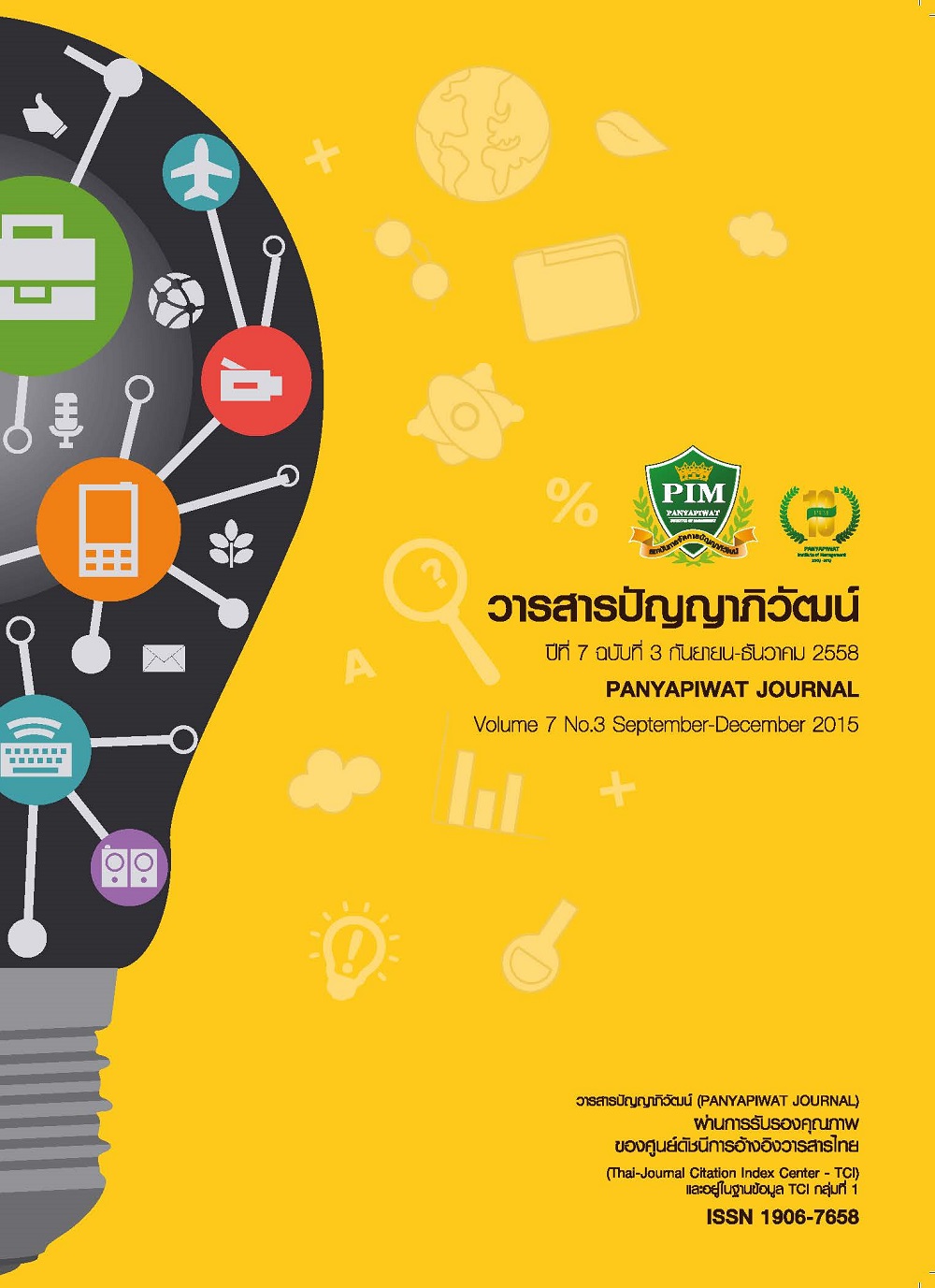องค์ประกอบที่มีผลต่อคุณค่าตราสินค้าของรีสอร์ทในจังหวัดเชียงใหม่ จากมุมมองของลูกค้าชาวไทย
Main Article Content
บทคัดย่อ
การวิจัยครั้งนี้มีวัตถุประสงค์เพื่อศึกษาองค์ประกอบที่มีผลต่อคุณค่าตราสินค้าของรีสอร์ทในจังหวัดเชียงใหม่จากมุมมองของลูกค้าชาวไทย โดยพัฒนาแบบสอบถามจากการศึกษาทฤษฎี และงานวิจัยที่เกี่ยวข้อง ตลอดจนสัมภาษณ์ผู้บริหารรีสอร์ทเพื่อสร้างดัชนีชี้วัดคุณค่าตราสินค้า จากนั้นพิจารณาน้ำหนักของแต่ละองค์ประกอบที่มีผลต่อคุณค่าตราสินค้าโดยการเก็บข้อมูลจากกลุ่มตัวอย่างนักท่องเที่ยวที่เคยใช้บริการที่พักแบบรีสอร์ทในจังหวัดเชียงใหม่ในระยะ 2 ปีที่ผ่านมา จำนวน 606 คน เพื่อนำมาตรวจสอบความตรงเชิงโครงสร้างตามทฤษฎีของ Aaker ด้วยการวิเคราะห์องค์ประกอบเชิงยืนยัน ผลการทดสอบพบว่า โมเดลการวัดคุณค่าตราสินค้าตามทฤษฎีสอดคล้องกับข้อมูลจากกลุ่มตัวอย่าง โดยคุณค่าตราสินค้าประกอบด้วย 5 องค์ประกอบ และสามารถเรียงลำดับตามขนาดอิทธิพลของแต่ละองค์ประกอบได้ดังนี้ 1) การรู้จักตราสินค้า 2) ความเชื่อมโยงตราสินค้า 3) การรับรู้คุณค่าตราสินค้า 4) ทรัพย์สินอื่นๆ และ 5) ความภักดีต่อตราสินค้า
This research aimed to explore the factors underlying the customer-based brand equity of resorts in Chiangmai and their relative importance. The questionnaire was developed from the review of related literature and research papers as well as the interview results of resort entrepreneurs. The developed scale was used to collect data from 606 tourists who used to stay in resorts in Chiang Mai in the past 2 years. The collected data were then analyzed employing second order confirmatory factor analysis. The findings revealed that there were five underlying factors in customer-based brand equity of resorts in Chiang Mai which were in accordance with Aaker’s Brand Equity Theory. These factors were, respectively in order of their relative effects, 1) Brand Awareness 2) Brand Associations 3) Brand Perceived Value 4) Other Proprietary Brand Equity and 5) Brand Loyalty.
Article Details
“ข้าพเจ้าและผู้เขียนร่วม (ถ้ามี) ขอรับรองว่า บทความที่เสนอมานี้ยังไม่เคยได้รับการตีพิมพ์และไม่ได้อยู่ระหว่างกระบวนการพิจารณาลงตีพิมพ์ในวารสารหรือแหล่งเผยแพร่อื่นใด ข้าพเจ้าและผู้เขียนร่วมยอมรับหลักเกณฑ์การพิจารณาต้นฉบับ ทั้งยินยอมให้กองบรรณาธิการมีสิทธิ์พิจารณาและตรวจแก้ต้นฉบับได้ตามที่เห็นสมควร พร้อมนี้ขอมอบลิขสิทธิ์บทความที่ได้รับการตีพิมพ์ให้แก่สถาบันการจัดการปัญญาภิวัฒน์หากมีการฟ้องร้องเรื่องการละเมิดลิขสิทธิ์เกี่ยวกับภาพ กราฟ ข้อความส่วนใดส่วนหนึ่งและ/หรือข้อคิดเห็นที่ปรากฏในบทความข้าพเจ้าและผู้เขียนร่วมยินยอมรับผิดชอบแต่เพียงฝ่ายเดียว”
เอกสารอ้างอิง
กรมการท่องเที่ยว กระทรวงการท่องเที่ยวและกีฬา. (2557). ข้อมูลที่พักในเชียงใหม่. สืบค้นเมื่อ 26 มกราคม 2557,จาก http://thai.tourismthailand.org
กรมการท่องเที่ยว กระทรวงการท่องเที่ยวและกีฬา. (2557) สถิติด้านการท่องเที่ยว ปี 2556. สืบค้นเมื่อ 26 มกราคม 2557, จาก http://www.mots.go.th
กัญวรา โภชน์อุดม. (2553). คุณค่าตราสินค้าธุรกิจออนไลน์ใน Second Life. วิทยานิพนธ์ วิทยาศาสตรมหาบัณฑิต สาขาวิชาการบริหารเทคโนโลยี วิทยาลัยนวัตกรรม, มหาวิทยาลัยธรรมศาสตร์.
ขวัญ พิพัฒนสุขมงคล. (2551). การพัฒนามาตรวัดการรับรู้ของนักท่องเที่ยวชาวไทยต่อคุณภาพการบริการของโรงแรม ในจังหวัดเชียงใหม่, วิทยานิพนธ์ บริหารธุรกิจมหาบัณฑิต สาขาเศรษฐศาสตร์, มหาวิทยาลัยเชียงใหม่.
เขมมิกา เชาวน์เกษม. (2550). การวัดมูลค่าตราสินค้าของผลิตภัณฑ์เครื่องสําอางเพื่อผิวขาวในจังหวัดเชียงใหม่ การค้นคว้าอิสระ บริหารธุรกิจมหาบัณฑิต สาขาวิชาเศรษฐศาสตร์ มหาวิทยาลัยเชียงใหม่.
ฉัตรชัย ยงค์มาย์วงศ์. (2555). การประเมินคุณค่าตราสินค้าเฟอร์นิเจอร์ บริษัท แพรคติก้า จํากัด. การประชุมวิชาการแห่งชาติ มหาวิทยาลัยเกษตรศาสตร์ วิทยาเขตกําแพงแสน ครั้งที่ 9.
เฉลิมพล ชนะมินทร์. (2556) ผลกระทบของคุณค่าตราสินค้าที่มีผลต่อการดําเนินงานของธุรกิจอาหารและเครื่องดื่ม ในประเทศไทย. วิทยานิพนธ์ บริหารธุรกิจมหาบัณฑิต สาขาการตลาด, มหาวิทยาลัยมหาสารคาม.
เต็มสิริ ตั้งจิตรสมบูรณ์. (2554). การวัดคุณค่าตราสินค้าธนาคารกรุงเทพ จํากัด (มหาชน) ของผู้ใช้บริการในเขตกรุงเทพมหานคร: กรณีศึกษาภาคนครหลวง 4. วิทยานิพนธ์ บริหารธุรกิจมหาบัณฑิต สาขาวิชาการประกอบการ,มหาวิทยาลัยศิลปากร.
ธนาคารเพื่อการส่งออกและนําเข้าแห่งประเทศไทย. (2556). วิเคราะห์ประเด็นธุรกิจ ภาคการท่องเที่ยว สืบค้นเมื่อ 26 มกราคม 2557, จาก http://www.exim.go.th/doc/newsCenter/43641.pdf
ธนาคารแห่งประเทศไทย. (2557). ประเด็นเศรษฐกิจในรอบปี 2557. สืบค้นเมื่อ 26 มกราคม 2557, จาก http://www.bot.or.th/Thai/Monetary Policy/EconomicConditions/Annual Report/AnnualReport/
annual_Y57_T.pdf
นริศ ธรรมเกื้อกูล, ไพฑูรย์ เจตธํารงค์ชัย, ทิพย์รัตน์ เลาหวิเชียร และนาวิน มีนะกรรณ. (2557). ปัจจัยที่มีอิทธิพลต่อความภักดีของลูกค้าร้านสะดวกซื้อ 7-Eleven ประเทศไทย. วารสารปัญญาภิวัฒน์, 6(1), 11-12 .
นริศร รักษ์วรรณา และสิริภักตร์ ศิริโท. (2554). การวัดมูลค่าตราสินค้าโดยรวมจากมุมมองของผู้บริโภค. วารสารนักบริหาร, 31(4), 213-223.
นัทธมน หมทอง. (2555), คุณค่าตราสินค้าที่มีผลต่อพฤติกรรมการซื้อโทรศัพท์มือถือไอโฟนของผู้บริโภคในกรุงเทพมหานคร. สารนิพนธ์ บริหารธุรกิจมหาบัณฑิต สาขาวิชาการตลาด, มหาวิทยาลัยศรีนครินทรวิโรฒ
ปัทมพร จิระบุญมา และสิริภักตร์ ศิริโท. (2556). คุณค่าตราสินค้าที่มีผลต่อการตัดสินใจซื้อรถยนต์ “ฮอนด้า” ของผู้บริโภคในกรุงเทพมหานคร. วารสารการตลาดและการสื่อสาร, 1(2), 282-296.
พงศ์ศิริ คําขันแก้ว และฐติกุล ไชยวรรณ์. (2555), อิทธิพลขององค์ประกอบคุณค่าตราสินค้าจากมุมมองของลูกค้าที่มีต่อความตั้งใจซื้อสินค้าเครื่องดื่มร้านกาแฟท้องถิ่นตรามิ่งมิตร จังหวัดเชียงใหม่, รายงานสืบเนื่องจากการประชุมวิชาการบัณฑิตศึกษาระดับชาติ ครั้งที่ 2 ประจําปี 2555.
ศูนย์วิจัยด้านการตลาดการท่องเที่ยว. (2558), จํานวนสถานที่พักแรมและห้องพัก ปี 2557-2558 ภาคเหนือ จังหวัดเชียงใหม่. สืบค้นเมื่อ 14 สิงหาคม 2558, จาก http://intelligencecenter.tat.or.th
สํานักงานส่งเสริมวิสาหกิจขนาดกลางและขาดย่อม. (2553). บทวิเคราะห์ธุรกิจโรงแรมและรีสอร์ท ปี 2553. สืบค้นเมื่อ 26 มกราคม 2557, จาก http://www.sme.go.th/SiteCollectionDocuments/วิจัยSMEs/สภาพแวดล้อม ทางธุรกิจ/รายงานบทวิเคราะห์ธุรกิจ%20ภาคการผลิตและบริการ/บทวิเคราะห์ธุรกิจโรงแรมและรีสอร์ท%20ปี6202553.pdf
อนุชิต ศิริกิจ. (2550), อิทธิพลของคุณลักษณะและภาพลักษณ์ตราผลิตภัณฑ์ที่มีผลต่อมูลค่าทุนตราผลิตภัณฑ์ของวิสาหกิจขนาดกลางและขนาดย่อม. วารสารพาณิชยศาสตร์บูรพาปริทัศน์, 3(1), 92-112.
Aaker, D. A. (1991). Managing brand equity: Capitalizing on the value of brand name. New York:free press.
Aaker, D. A. (2013). Strategic Market Management (10th ed.). New Jerseys: Wiley.
Churchill Jr, G. A. (1979). A paradigm for developing better measure of marketing construct. Journal of Marketing Research, 16(2), 64-73.
Dobni, D. & Zinkhan, G. M. (1990). In search of brand image: A foundation analysis. In Goldberg,M. E., Gorn, G. & Pollay, R. W. (eds.). Advance in Consumer Research (pp.110-119). Provo. UT: Association for Consumer Research.
Hair, Jr. J. F., Black, W. C., Babin, B. J. & Anderson, R. E. (2009). Multivariate Data Analysis. (7th ed.).Upper Saddle River, NJ: Prentice-Hall.
Keller, K. L. (1993). Conceptualizing, measuring, and managing customer-based brand equity. Journal of Marketing, 57(1), 1-22.
Keller, K. L. (2013). Strategic brand management: building, measuring and managing brand equity. Upper Saddle River, NJ: Prentice-Hall.
Kotler, C. K. (2009). How reputation creates loyalty in the restaurant sector. International Journal of contemporary hospitality management, 25(4), 536-557.
Vendelo, M. T. (1998). Narrating corporate reputation: Becoming legitimate though storytelling. International Studies of Management & Organization, 28(3), 120-137.
Translated Thai References
Bank of Thailand. (2014). Thailand's Economic Conditions in 2014. Retrieved January 26, 2014,from http://www.bot.or.th/Thai/MonetaryPolicy/EconomicConditions/Annual Report/AnnualReport/annual_Y57_1.pdf [in Thai]
Chanamin, C. (2013). The Effects of Brand Equity on the Performance of Food and Beverage Industry in Thailand. Thesis. Master of Business Administration, Marketing, Mahasarakham University. [in Thai]
Chaokasem, K. (2007). Brand Equity Measurement in Whitening Cosmetic Product in Chiang Mai Province. Independent Study. Master of Business Administration, Economics, Chiangmai University. [in Thai]
Department of Tourism, Ministry of Tourism and Sports. (2014). Hotels in Chiang Mai Statistics. Retrieved January 26, 2014, from http://thai.tourismthailand.org [in Thai]
Department of Tourism, Ministry of Tourism and Sports. (2014). Tourist Statistics 2013. Retrieved January 26, 2014, from http://www.mots.go.th [in Thai]
Export-Import Bank of Thailand (2013). Analysis of Tourism Investments. Retrieved January 26,2014, from http://www.exim.go.th/doc/newsCenter/43641.pdf [in Thai]
Homthong, N. (2012). Brand Equity Affecting Buying Behavior Toward Iphone of Consumer in Bangkok Metropolis. Master of Business Administration Program Marketing, Srinakharinwirot University. [in Thai]
Intelligence Center. (2015). The Number of Accommodations and Rooms 2014-2015 Northern Region, Chiang Mai. Retrieved August 14, 2015, from http://intelligencecenter.tat.or.th [in Thai]
Jiraboonma, P. & Siritho, S. (2013). Brand Equity Influencing Purchase Decision toward Honda's Car of Consumers in Bangkok Metropolis. Journal of Marketing and Communication, 1(2), 282-296.[in Thai]
Kamkankaew, P. & Chaiwun, T. (2012). The Effect of Customer-Based Brand Equity Components on Purchase Intention of the Mingmitr Local Coffee Bars in Chiang Mai Province. Proceeding of the National Graduate Conference 2013. [in Thai]
Phojudom, K. (2010). Brand Equity across Online Companies in Second Life. Thesis. Master of Science, Technology Management, College of Innovation, Thammasat University. [in Thai]
Pipattanasookmongkol, K. (2008). Scale Development for Measuring Thai Tourist Perception towards Service Quality of Hotels in Chiangmai Province. Thesis. Master of Business Administration, Economics, Chiang Mai University. [in Thai]
Rakwanna, N. & Siritho, S. (2011). Brand Equity Measurement from Consumers' Perspective. Executive Journal, 31(4), 213-223. [in Thai]
Sirikit, A. (2007). Influencing of Brand Attributes and Brand Image on Brand Equity for SME. Journal of commerce - Burapha Review, 3(1), 92-112. [in Thai]
Tangjitsomboon, T. (2011). Bangkok Bank Public Company Limited Brand Equity Measurement Case Study Bangkok Metropolis 4. Thesis. Master of Business Administration Program in Entrepreneurship Program of Entrepreneurship Graduate School, Silpakorn University.[in Thai]
Thamkuekool, N., Chetthamrongchai, P., Laohavichien, T. & Meenakan, N. (2014). Factors That Impact on Customer Loyalty of 7-Eleven Thailand. Panyapiwat Journal, 6(1), 11-12. [in Thai]
The Office of SMEs Promotion. (2010). Analysis Hotel and Resorts year 2010. Retrieved January 26, 2014, from http://www.sme.go.th/SiteCollection Documents [in Thai]
Yongmawong, C. (2012). Measuring Brand Equity for Furniture Brand of Practika Company Limited. The 9th International Conference. Kasetsart University Kamphaeng- saen Campus. [in Thai]


